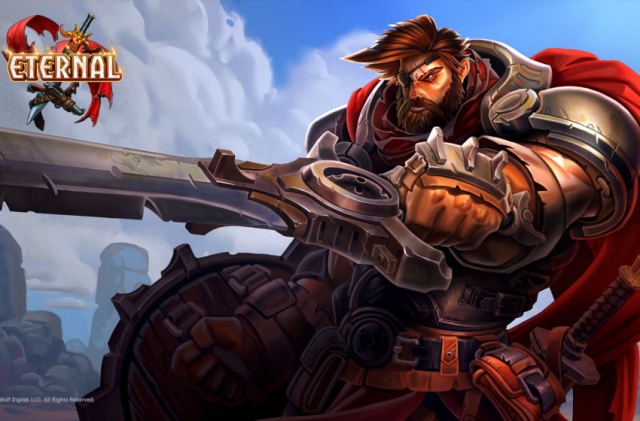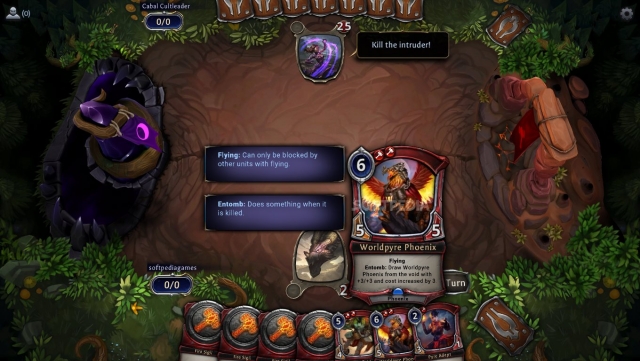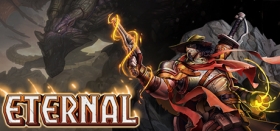
So I Tried... Eternal
Welcome to another edition of So I Tried, the GameGrin segment where our staff spends 30 minutes with a game before leaving it in the dead of night after raiding its wallet for cab fare. Will it be a one night stand? Or will this brief introduction be the start of a long and tender relationship that ends with us passionately declaring our love right as the game’s boarding a flight to Seattle? Has this analogy run on for too long to serve its purpose? Find out the answer to these questions and more as we try… Eternal
What I Thought It Was

Even when the price tag has a big fat “Free” on it, I tend to be a bit discerning when adding titles to my Steam library- harumph harumph- and Dire Wolf Digital’s Eternal on the surface certainly seemed to meet my self-congratulatory elitist standards! From the trailers and screenshots I looked through, I saw a digital CCG in a similar vein to Hearthstone. My last experience with colorful digital representations of thin pasteboard had been Y-Go-Pro, a free Yugioh online simulator, and so Eternal’s artwork gave off this fantasy western feel that felt new and appealing. And to clarify, when I say “similar to Hearthstone” what I mean to say is “looks similar to Hearthstone”. I’ve never had the pleasure of sampling what was Blizzard’s blend of WoW-based amphetamine before Overwatch rolled along, so that should give you at least some idea of the kind of bias I’m packing. Eternal was the first real member of its genre I’ve tried, but given the pedigree of its cousins I went in with high expectations.
What It Actually Is

Such expectations were thankfully satisfied… mostly, during my time with the game. Eternal is played oddly enough like one plays a military shooter; if you decide to pick it up I would recommend you start with the campaign and then move on to the ranked online matches. The campaign itself is essentially a short gauntlet of moderately competent AI’s playing decks designed to show off the five “families” or card types of the game. There’s primal, shadow, time, fire, and justice. Or if you’re more interested in mechanics there’s fliers, life-stealers, card-drawer’s with effects that activate each time you play a mana card, damage-oriented bruisers, and lots of small fry that pump each other up and focus on defense, respectively. Those among you that play Magic: The Gathering might notice that I’m using some familiar terminology here and there in my descriptions, and there’s a reason for that. Aside from some interesting new mechanics like cards that give your character weapons allowing them to fight directly, Eternal’s rules are largely based off of MTG. Whether or not this is a good thing comes down to your personal preference, but to me it was an interesting take on a system I was already familiar with.
Beyond this basic introduction and tutorial, the campaign never really had much going for it story-wise. As a lore junkie I was eager to learn more about the samurai-inspired Oni, the magi of the Praxis Arcanum college (desert mages with time powers), the cowboy outlanders, and how these archetypes interacted with each other. The combination of six-gun bandolier-wearing action with high fantasy magic was something I had scarcely seen anywhere else and I think Dire Wolf may be missing out on an opportunity here. Although there was also a secondary campaign that you can access with enough in-game or micro-transaction currency, so maybe I’m not giving story mode an entirely fair deal here.
Speaking of currency, one of Eternal’s more appreciated aspects is its insistence on making almost everything in the game purchasable with in-game currency. It’s rare nowadays to see a free to play game that allows you to buy extraneous things like background customizations (this game’s equivalent of skins) using currency you fake-earned. Not that I’m complaining! This same currency also allows you to buy randomised booster packs and rounds of special game modes like drafts and elimination gauntlets against ever more challenging AIs. There’s also ‘shards’, a resource you get from destroying extra cards in order to craft new ones, and the different chests of gold, cards, and packs which are your reward for crushing your opponent’s ambitions for victory like pitiful worms in the dust … Here’s your chest you monster. Excessively dark humor aside, Eternal’s ranked system is what one might expect. Some players are bad, some players are good, some players have figured out new and magically broken combinations that you can rage at before plagiarizing in your next game. There’s also what I consider to be the added bonus of only being able to communicate with your opponent through preset reactions, like in Hearthstone. It’s a game that uses all these different resource types to upgrade your deck and your assorted bling as you climb the ladder and put in your due diligence. I never felt like I was earning gold or shards at too slow a pace for me to stay motivated to keep playing. If hitting that sort of economic goldilocks zone is your version of an endorsement, then there it is.
Will I Keep Playing

It’s probably what I’m going to do once I finish writing this article, so yes. Eternal is from what I can tell, a competent polygamous marriage between MTG’s gameplay, Hearthstone’s look and feel, and an admirable dedication to rewarding the player for their time investment. While it lacks a recognizable story, which I found disappointing, it does what it does well enough so that it doesn’t need one to hold your interest well past your finishing the campaign.









COMMENTS